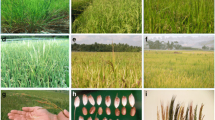Abstract
Argentine wheat cultivars are assumed to be essentially vernalization insensitive or very slightly sensitive. However, there are only speculations on this lack of vernalization requirement and a greater unawareness on the variation in earliness per se. The aims of this research have been to determine the extent of variability in vernalization requirement and earliness per se, and how the variability in both traits was produced by breeding programs, through the release of wheat cultivars from the 1930's to the 1990's in Argentina. Sixty-eight cultivars, selected among those of highest performance in each era, were evaluated under field and glasshouse conditions for their vernalization response and earliness per se. Forty per cent of the cultivars showed some vernalization response. There was a decrease in this requirement along the first decades of the analysed breeding period, likely in response to the considerable introgression of CIMMYT germplasm. This initial trend to release earlier cultivars was also evidenced in a clear decrease in earliness per se. As this tendency in both characteristics was reverted during the last two decades, it may denote that certain vernalization response and not extreme earliness per se, may contribute to achieve higher yield cultivars in our area.
Similar content being viewed by others
References
Appendino, M.L., G. Pérez Camargo & E.Y. Suárez, 1993. Caracterización bioclimática de cultivares de trigo argentinos. RIA 24: 1-7.
Cahalan, C. & C.N. Law, 1979. The genetical control of cold resistance and vernalization requirement in wheat. Heredity 42: 125-132.
Calderini, D.F., M.P. Reynolds & G.A. Slafer, 1999. Genetic gains in wheat yield and main physiological changes associated with them during the 20th century. In: E.H. Satorre & G.A. Slafer, (Ed.), Wheat: Ecology and Physiology of Yield Determination, pp. 351-377. Food Product Press, New York.
Davidson, J.L., K.R. Christian, D.B. Jones & P.M. Bremner, 1985. Responses of wheat to vernalization and photoperiod. Aust J Agric Res 36: 347-359.
Feil, B., 1992. Breeding progress in small grain cereals. A comparison of old and modern cultivars. Plant Breed 108: 1-11.
Fisher, R.A., 1983. Wheat. In: W.H. Smith & J.J. Banta, (Ed.), Potential Productivity of Field Crops under Different Environments, pp. 129-154. Los Baños, IRRI.
Flood, R.G. & G.M. Halloran, 1986. Genetics and physiology of vernalization response in wheat. Adv in Agronomy 39: 87-123.
Haun, J.R., 1973. Visual qualification of wheat development. Agronomy J 65: 116-119.
Hoogendoorn, J., 1985. A reciprocal F1 analysis of the genetic control of ear emergence, number of leaves and number of spikelets in wheat. Euphytica 34: 545-555.
Law, C.N., 1987. The genetic control of daylenght response in wheat. In: J.G. Atherton (Ed.), Manipulation of Flowering, Proc 45th Nottingham Easter School in Agricultural Science, pp. 225-240. Butterworths, London, UK.
Loss, S.P. & K.H.M. Siddique, 1994. Morphological and physiological traits associated with wheat yield increases in Mediterranean environments. Adv in Agronomy 52: 229-276.
Maystrenko, O.I., 1980. Cytogenetic study of the growth habit and ear-emergence time in wheat Triticum aestivum L. In: Well-being of Mankind and Genetics. Proc XIVth Int Congress of Genetics, MIR, Moscow, pp. 267-282.
Miura, H. & A.J. Worland, 1994. Genetic control of vernalization, day-length response, and earliness per se by homeologous group-3 chromosomes in wheat. Plant Breed 113: 160-169.
Pugsley, A.T., 1972. Additional genes inhibiting winter habit in wheat. Euphytica 21: 547-552.
Scarth, R. & C.N. Law, 1983. The location of the photoperiod gene, Ppd2, and an additional genetic factor for ear-emergence time on chromosome 2B of wheat. Heredity 51: 607-619.
Slafer, G.A., 1996. Differences in phasic development rate amongst wheat cultivars independent of responses to photoperiod and vernalization. A viewpoint of the intrinsic earliness hypothesis. J Agric Sci (Cambridge) 126: 403-419.
Slafer, G.A. & F.H. Andrade, 1991. Changes in physiological attributes of the dry matter economy of bread wheat (Triticum aestivum) through genetic improvement of grain yield potential at different regions of the world. A review. Euphytica 58: 37-49.
Slafer, G.A. & J.L. Araus, 1998. Keynote address: Improving wheat responses to abiotic stresses. In: Proc 9th Int Wheat Genet Symp Vol. 1, (Keynote address). Saskatoon: University of Saskatchewan Extension Press.
Slafer, G.A. & H.M. Rawson, 1994. Sensitivity of wheat phasic development to major environmental factors: a reexamination of some assumptions made by physiologists and modellers. Aust J Plant Physiol 21: 393-426.
Slafer, G.A. & H.M. Rawson, 1995. Intrinsic earliness and basic development rate assessed for their response to temperature in wheat genotypes. Euphytica 83: 175-183.
Slafer, G.A. & E.M. Whitechurch, 2001. Manipulating wheat development to improve adaptation and to search for alternative opportunities to increase yield potential. In: M.P. Reynolds, J.I. Ortiz-Monasterio & A. McNab (Eds.), Application of Physiology to Wheat Breeding, pp. 160-170. CIMMYT, Mexico D.F.
Slafer, G.A, L.G. Abeledo, D.J. Miralles, F.G. González & E.M. Whitechurch, 2001. Photoperiod sensitivity during stem elongation as an avenue to rise potential yield in wheat. Euphytica 119: 191-197.
Snape, J.W., K. Butterworth, E.M. Whitechurch & A.J. Worland, 2001. Waiting for fine times: genetics of flowering time in wheat. Euphytica 119: 185-190.
Stelmakh, A.F., 1993. Genetic effects of Vrn genes on heading date and agronomic traits in bread wheat. Euphytica 65: 53-60.
Worland, A.J., 1996. The influence of flowering time genes on environmental adaptability in European wheats. Euphytica 89: 49-57.
Xin, Z.Y., C.N. Law & A.J. Worland, 1988. Studies of the effect of the vernalization responsive genes on the chromosomes of homeologous group 5 of wheat. In: Proc 7th Int Wheat Genet Symp. Cambridge, U.K.
Author information
Authors and Affiliations
Rights and permissions
About this article
Cite this article
Appendino, M.L., Bartoloni, N. & Slafer, G.A. Vernalization response and earliness per se in cultivars representing different eras of wheat breeding in Argentina. Euphytica 130, 61–69 (2003). https://doi.org/10.1023/A:1022376711850
Issue Date:
DOI: https://doi.org/10.1023/A:1022376711850




